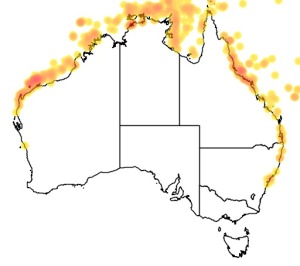Colours
Distinguishing features
A large, fast moving silvery fish with a speckling of fine black spots over the flank, and a dark spot on the upper pectoral fin base. Usually seen singly or in pairs along the edges of reefs and in passes. The largest Trevally.
Size
- Up to 170 cm (Standard length)
Depth range
- Depth range data is not yet available.
Synonyms
Distribution
Distribution and habitat preferences
Areas of deep water close to reef edges, favours locations with good water movement and plentiful schools of planktivorous prey fish.
Can be found in most reef habitats around the island, although prefers reef margins near deep water.
Behaviour
The largest trevally, this species is considered an apex predator in coral reef environments, feeding on both pelagic and reef associated fishes and invertebrates. Giant Trevallies in Hawaii have been shown to roam widely over their home reefs, regularly patrolling areas of up to 5km and occasionally making movements as far as 30km across whole atolls to visit spawning sites. Juveniles of this species are found in shallow estuary habitats and migrate out to reefal waters at about 25-30cm length. This species is mature at about 4 years and lives to more than 12 years.
Web resources
Danger
- unspecified - This species is known to have caused ciguatera poisoning and should not be eaten.
References
References that assist with identification
- Randall, J.E., G.R. Allen and R.C. Steene (1990). Fishes of the Great Barrier Reef and Coral Sea University of Hawaii Press, Honolulu, Hawaii.
Other references
- Burdon-Jones, C. and G.R.W. Denton (1981). Metals in marine organisms from the Great Barrier Reef Province. Part 1. Base line survey,Interim Progress Report, James Cook University, Townsville.. LIRS catalog number 69.
- Graham, R.T. and D.W. Castellanos (2005). Courtship and spawning behaviors of carangid species in Belize, Fishery Bulletin, 103: 426-432. LIRS catalog number 90033.
- View all references





